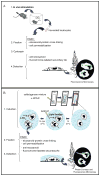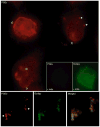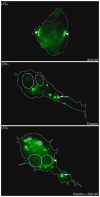EicosaCell - an immunofluorescent-based assay to localize newly synthesized eicosanoid lipid mediators at intracellular sites
- PMID: 21153792
- PMCID: PMC3679533
- DOI: 10.1007/978-1-60761-950-5_10
EicosaCell - an immunofluorescent-based assay to localize newly synthesized eicosanoid lipid mediators at intracellular sites
Abstract
Eicosanoids (prostaglandins, leukotrienes and lipoxins) are a family of signaling lipids derived from arachidonic acid that have important roles in physiological and pathological processes. Over the past years, it has been established that successful eicosanoid production is not merely determined by arachidonic acid and eicosanoid-forming enzymes availability, but requires sequential interactions between specific biosynthetic proteins acting in cascade and may involve very unique spatial interactions. Direct assessment of specific subcellular locales of eicosanoid synthesis has been elusive, as those lipid mediators are newly formed, not stored and often rapidly released upon cell stimulation. In this chapter, we discuss the EicosaCell protocol for intracellular detection of eicosanoid-synthesizing compartments by means of a strategy to covalently cross-link and immobilize the lipid mediators at their sites of synthesis followed by immunofluorescent-based localization of the targeted eicosanoid.
Figures





Similar articles
-
Identifying intracellular sites of eicosanoid lipid mediator synthesis with EicosaCell assays.Methods Mol Biol. 2011;717:277-89. doi: 10.1007/978-1-61779-024-9_16. Methods Mol Biol. 2011. PMID: 21370037 Free PMC article. Review.
-
EicosaCell: An Imaging-Based Assay to Identify Spatiotemporal Eicosanoid Synthesis.Methods Mol Biol. 2017;1554:127-141. doi: 10.1007/978-1-4939-6759-9_6. Methods Mol Biol. 2017. PMID: 28185186 Free PMC article.
-
Lipid body function in eicosanoid synthesis: an update.Prostaglandins Leukot Essent Fatty Acids. 2011 Nov;85(5):205-13. doi: 10.1016/j.plefa.2011.04.020. Epub 2011 May 12. Prostaglandins Leukot Essent Fatty Acids. 2011. PMID: 21565480 Review.
-
Lipid bodies: intracellular sites for eicosanoid formation.J Allergy Clin Immunol. 1994 Dec;94(6 Pt 2):1151-6. doi: 10.1016/0091-6749(94)90325-5. J Allergy Clin Immunol. 1994. PMID: 7798553 Review.
-
Eicosanoid transcellular biosynthesis: from cell-cell interactions to in vivo tissue responses.Pharmacol Rev. 2006 Sep;58(3):375-88. doi: 10.1124/pr.58.3.8. Pharmacol Rev. 2006. PMID: 16968946 Review.
Cited by
-
Crotalus durissus ruruima Snake Venom and a Phospholipase A2 Isolated from This Venom Elicit Macrophages to Form Lipid Droplets and Synthesize Inflammatory Lipid Mediators.J Immunol Res. 2019 Nov 4;2019:2745286. doi: 10.1155/2019/2745286. eCollection 2019. J Immunol Res. 2019. PMID: 31781674 Free PMC article.
-
A Snake Venom-Secreted Phospholipase A2 Induces Foam Cell Formation Depending on the Activation of Factors Involved in Lipid Homeostasis.Mediators Inflamm. 2018 Jun 14;2018:2547918. doi: 10.1155/2018/2547918. eCollection 2018. Mediators Inflamm. 2018. PMID: 30013451 Free PMC article.
-
Leptin Mediates In Vivo Neutrophil Migration: Involvement of Tumor Necrosis Factor-Alpha and CXCL1.Front Immunol. 2018 Feb 6;9:111. doi: 10.3389/fimmu.2018.00111. eCollection 2018. Front Immunol. 2018. PMID: 29467755 Free PMC article.
-
Lipid Bodies as Sites of Prostaglandin E2 Synthesis During Chagas Disease: Impact in the Parasite Escape Mechanism.Front Microbiol. 2018 Mar 20;9:499. doi: 10.3389/fmicb.2018.00499. eCollection 2018. Front Microbiol. 2018. PMID: 29616011 Free PMC article. Review.
-
Unraveling the complexity of lipid body organelles in human eosinophils.J Leukoc Biol. 2014 Nov;96(5):703-12. doi: 10.1189/jlb.3RU0214-110R. Epub 2014 Sep 10. J Leukoc Biol. 2014. PMID: 25210147 Free PMC article. Review.
References
-
- Yaqoob P. Fatty acids as gatekeepers of immune cell regulation. Trends Immunol. 2003;24:639–645. - PubMed
-
- Wymann MP, Schneiter R. Lipid signaling in disease. Nat Rev Mol Cell Biol. 2008;9:162–176. - PubMed
-
- Smith WL, DeWitt DL, Garavito RM. Cyclooxygenases: structural, cellular, and molecular biology. Annu Rev Biochem. 2000;69:145–182. - PubMed
Publication types
MeSH terms
Substances
Grants and funding
LinkOut - more resources
Full Text Sources
Miscellaneous

